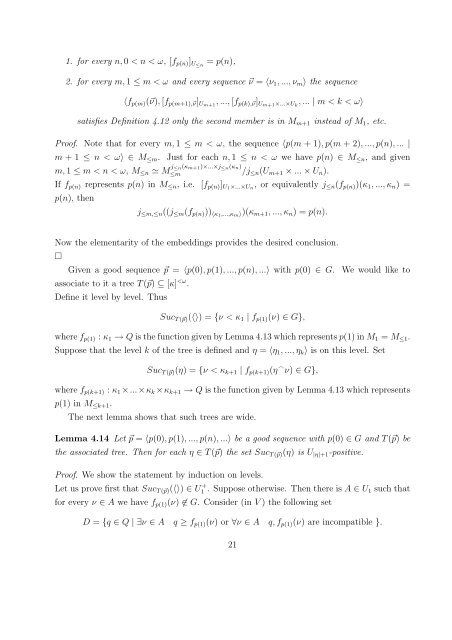On changing cofinality of partially ordered sets
On changing cofinality of partially ordered sets
On changing cofinality of partially ordered sets
You also want an ePaper? Increase the reach of your titles
YUMPU automatically turns print PDFs into web optimized ePapers that Google loves.
1. for every n, 0 < n < ω, [f p(n) ] U≤n = p(n),<br />
2. for every m, 1 ≤ m < ω and every sequence ⃗ν = 〈ν 1 , ..., ν m 〉 the sequence<br />
〈f p(m) (⃗ν), [f p(m+1),⃗ν ] Um+1 , ..., [f p(k),⃗ν ] Um+1 ×...×U k<br />
, ... | m < k < ω〉<br />
satisfies Definition 4.12 only the second member is in M m+1 instead <strong>of</strong> M 1 , etc.<br />
Pro<strong>of</strong>. Note that for every m, 1 ≤ m < ω, the sequence 〈p(m + 1), p(m + 2), ..., p(n), ... |<br />
m + 1 ≤ n < ω〉 ∈ M ≤m . Just for each n, 1 ≤ n < ω we have p(n) ∈ M ≤n , and given<br />
m, 1 ≤ m < n < ω, M ≤n ≃ M j ≤n(κ m+1 )×...×j ≤n (κ n)<br />
≤m /j ≤n (U m+1 × ... × U n ).<br />
If f p(n) represents p(n) in M ≤n , i.e. [f p(n) ] U1 ×...×U n<br />
, or equivalently j ≤n (f p(n) )(κ 1 , ..., κ n ) =<br />
p(n), then<br />
j ≤m,≤n ((j ≤m (f p(n) )) 〈κ1 ,...,κ m〉)(κ m+1 , ..., κ n ) = p(n).<br />
Now the elementarity <strong>of</strong> the embeddings provides the desired conclusion.<br />
□<br />
Given a good sequence ⃗p = 〈p(0), p(1), ..., p(n), ...〉 with p(0) ∈ G.<br />
associate to it a tree T (⃗p) ⊆ [κ]
















